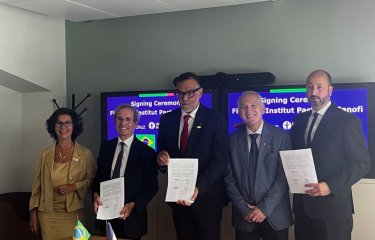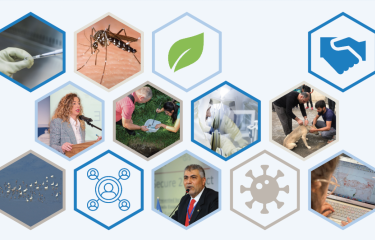Entomology, the study of insects, is a long-standing tradition at the Institut Pasteur. Institut Pasteur scientist Alphonse Laveran was the first to describe the malaria agent, Plasmodium, in 1880, while working in Constantine, Algeria. His work on protozoa earned him the Nobel Prize in 1907. In 1898, Paul-Louis Simond demonstrated that the bacterium responsible for plague, the Yersinia pestis bacillus discovered in 1894 by Alexandre Yersin, was spread by fleas. A few years later, in 1909, at the Institut Pasteur in Tunis, Charles Nicolle revealed the role of the louse Pediculus humanus in spreading typhus caused by the bacterium Rickettsia prowazekii. He was awarded the Nobel Prize for his discovery in 1928. These illustrious Institut Pasteur scientists firmly established medical entomology as a typically Pasteurian discipline.
It was therefore a subject that was taught at the Institut Pasteur, initially by Prof. Emile Roubaud, who set up the first entomology laboratory in 1914. A course run jointly by ORSTOM (now the IRD, or French National Research Institute for Sustainable Development) and the Medical Entomology Department at the Institut Pasteur, directed at the time by Prof. Paul Grenier, was set up in the 1960s. The two-year program was followed by a practical internship of at least six months at the Muraz Center in Bobo-Dioulasso, Upper Volta (now Burkina Faso). The course ended in the 1970s. In 1988, given the alarming situation facing the discipline, the management team at the Institut Pasteur in Paris decided to set up a medical entomology course, directed by Prof. François Rodhain and Dr. Claudine Perez-Eid. The three-month course was offered every other year for French-speaking students. In 2004, the name and structure of the course changed; the new two-month "Arthropod Vectors and Human Health" program was directed by Prof. Paul Reiter from the Institut Pasteur and Dr. Vincent Robert from the IRD. After just three sessions, the course was discontinued in 2011. It was only in March 2016 that it was brought back again in a new format and renamed "Insect Vectors and Transmission of Pathogenic Agents" (IVTPA). The new course lasts one month and is offered on a dual-education basis together with a two-week workshop held at one of the institutes in the Institut Pasteur International Network. Alongside the IVTPA course, a "Medical Entomology" MOOC is now available, containing thirty ten-minute videos and designed to be completed over a six-week period.
Since 1988, the Institut Pasteur's medical entomology course, in its various formats, has been completed by 173 students, with 38% coming from the Institut Pasteur International Network and nearly a third from Africa. We hope that this program will continue for many years to come. We would like to finish this brief overview of medical entomology teaching at the Institut Pasteur with a wise old saying: "Those that know, do. Those that understand, teach."
By Anna-Bella Failloux1 and François Rodhain2
1. Institut Pasteur, Department of Virology, Arboviruses and Insect Vectors
2. Honorary Professor at the Institut Pasteur








